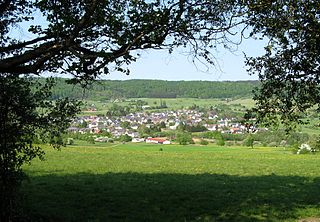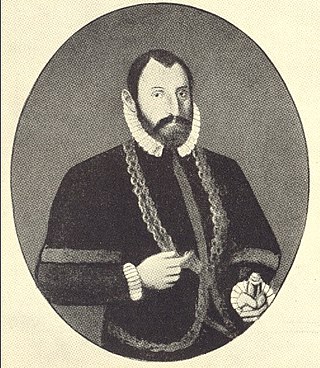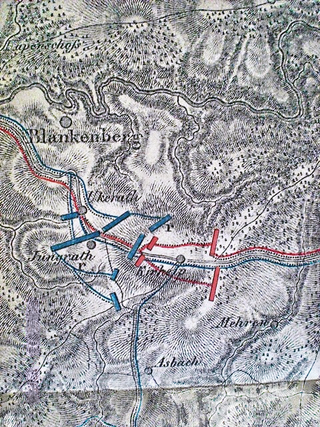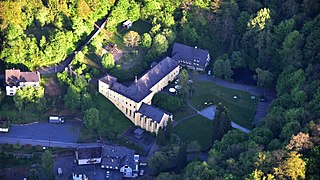
The Westerwald is a low mountain range on the right bank of the river Rhine in the German federal states of Rhineland-Palatinate, Hesse and North Rhine-Westphalia. It is a part of the Rhenish Massif. Its highest elevation, at 657 m above sea level, is the Fuchskaute in the High Westerwald.

Sayn-Wittgenstein was a county of medieval Germany, located in the Sauerland of eastern North Rhine-Westphalia.

Sayn was a small German county of the Holy Roman Empire which, during the Middle Ages, existed within what is today Rheinland-Pfalz.

Sayn-Wittgenstein-Hachenburg was a German County located in Rhineland-Palatinate, near the river Sieg.

Sayn-Wittgenstein-Sayn was a county of Rhineland-Palatinate, Germany, comprising the lands of the region of Sayn. It was created as a partition of Sayn-Wittgenstein in 1607, although it was not until the next year that it obtained fully the Countship of Sayn. The succession was never clear, leading to the annexation of the county in 1623 by the Archbishop of Cologne. It was not until a treaty in 1648 that it was decided the county would pass to the sisters Ernestine and Johanette of Sayn-Wittgenstein-Sayn, under the regency of their mother, Countess Louise Juliane von Erbach (1603–1670). They partitioned the county into Sayn-Wittgenstein-Sayn-Altenkirchen and Sayn-Wittgenstein-Hachenburg soon after.

Hachenburg is a town in the Westerwaldkreis in Rhineland-Palatinate, Germany.

Hattert is an Ortsgemeinde – a community belonging to a Verbandsgemeinde – in the Westerwaldkreis in Rhineland-Palatinate, Germany. It is the biggest Ortsgemeinde in the Verbandsgemeinde of Hachenburg, a kind of collective municipality.

The County of Sponheim was an independent territory in the Holy Roman Empire that lasted from the 11th century until the early 19th century. The name comes from the municipality of Sponheim, where the counts had their original residence.
Frederick of Nassau-Weilburg was the ruling Count of Nassau-Weilburg from 1655 to 1675.
Countess Louise Juliane of Erbach was a German regent; Countess of Sayn-Wittgenstein-Sayn by marriage to Ernest of Sayn-Wittgenstein-Sayn, she acted temporarily as regent of Sayn-Wittgenstein-Sayn. She is remembered as the title character of the novel Die Gräfin von Sayn by Karl Ramseger-Mühle.

Louis I, Count of Sayn-Wittgenstein, nicknamed "the Elder", formally "Louis I of Sayn, Count at Wittgenstein" ruled the County of Wittgenstein, on the upper reaches of the rivers Lahn and Eder, from 1558 until his death. He converted his county to Calvinism and was an influential politician in the service to the Electoral Palatinate.
Johannetta, Countess of Sayn-Wittgenstein-Sayn-Altenkirchen, was Sovereign Countess of Sayn-Wittgenstein-Sayn-Altenkirchen from 1648 to 1701. She was also Landgravine of Hesse-Braubach by marriage to John, Landgrave of Hesse-Braubach, and Duchess of Saxe-Marksuhl by marriage to John George I, Duke of Saxe-Eisenach.
Ernestine of Sayn-Wittgenstein, was a German ruler, Sovereign Countess of Sayn-Wittgenstein-Hachenburg in 1648-1661. She was also Countess consort of Manderscheid-Blankenheim by marriage to.

Henry IV of Sayn, Lord of Homburg, Montclair and Meinsberg was the last Count of Sayn-Sayn and the last male heir of the Sayn-Sponheim family.

The Battle of Kircheib was a military engagement during the War of the First Coalition. On 19 June 1796, French and Austrian troops clashed at Kircheib in the Westerwald uplands in present-day Germany. Sometimes it is called the Battle of Uckerath after another nearby village, Uckerath, which belongs today to Hennef.

The Franciscan Abbey of Hachenburg was a monastery of the Franciscan order in Hachenburg in the county of Westerwaldkreis in Germany. The abbey of fratrum minorum observantiae strictioris St. Francisci Seraphici belonged to the Thuringian Franciscan Province of Saint Elisabeth.

The Battle of Siegburg was the first engagement of the French offensive across the River Rhine - that offensive was to become the main campaign of 1796 during the War of the First Coalition. On 30 May 1796 général de division Jean-Baptiste Kléber crossed the river at Düsseldorf with the two divisions commanded by général de division Lefebvre and général de division Colaud. He then moved on Siegburg, where he won the battle on 1 June, thus enabling general Jean-Baptiste Jourdan to bring the bulk of his force across the Rhine at Neuwied.

Marienthal Abbey was a Franziscan monastery in the Westerwald in the present-day county of Altenkirchen in the German state of Rhineland-Palatinate. Today Marienthal is a village in the municipality of Seelbach bei Hamm (Sieg). On 30 June 2011 it had a population of 55.

Marienstatt Abbey is a Cistercian monastery and a pilgrimage site in Streithausen, Westerwaldkreis, Rhineland-Palatinate, in the Nister valley near Hachenburg.

Friedrich Uhlhorn was an honorary professor at the Philipps-Universität Marburg, whose scientific focus was on the history of the State of Hesse and was also known for his work outside Hesse. His special scientific interest was mainly focused on the problems of historical cartography. In collaboration with Edmund Ernst Stengel, he published the Geschichtlichen Atlas von Hessen, which is considered his major work. He also wrote the article Die deutschen Territorien. A: The West, which deals with the West German regional history. Likewise he was responsible as editor for the Hessisches Jahrbuch für Landesgeschichte by Bruno Gebhardt.
















